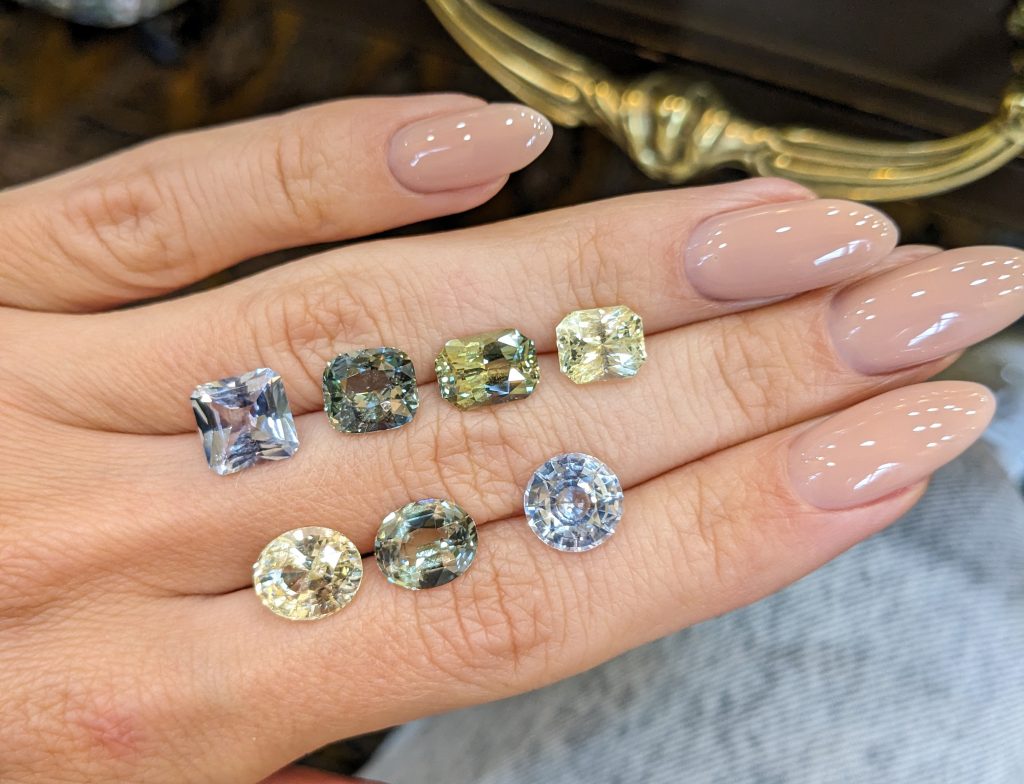
Treatments and enhancements in gemstones refer to various processes that are applied to natural gemstones to improve their appearance, durability, or overall value. These treatments can range from simple cleaning and polishing to more complex procedures that alter the gemstone’s color, clarity, or other characteristics. Here are some common treatments and enhancements used in the gemstone industry:
Heat treatment as Treatments and Enhancements
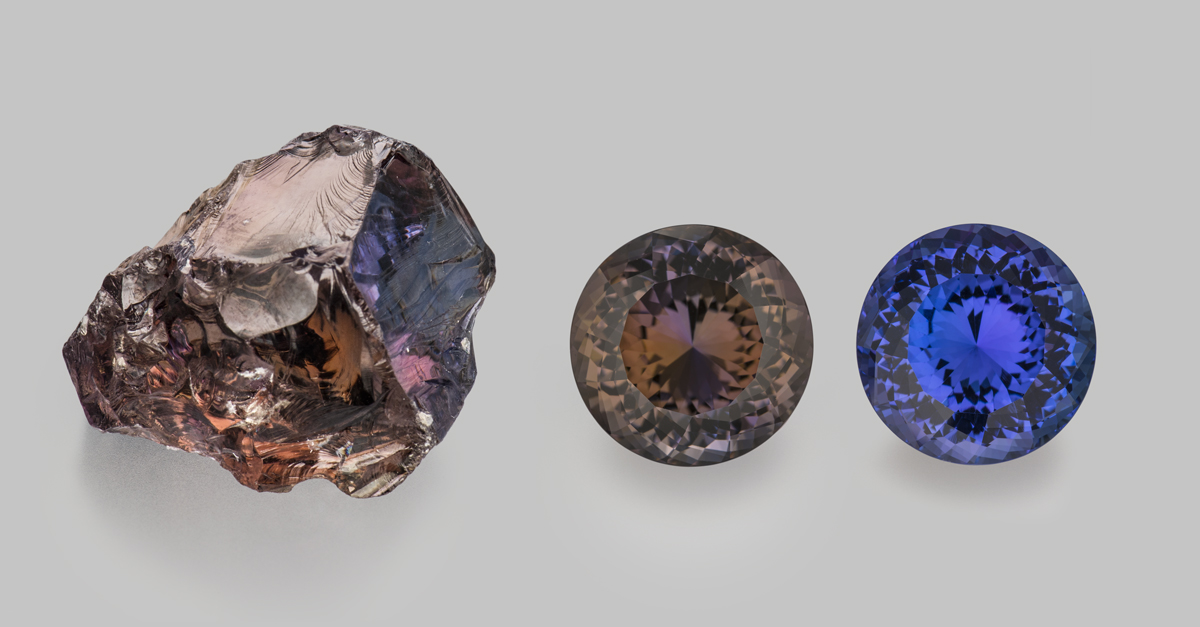
A 16.57 carat Tanzanite cut from the crystal is shown before and after heat treatment.
Heat treatment is one of the most common and widely accepted methods of Treatments and Enhancements in enhancing the appearance of gemstones. It involves subjecting a gemstone to controlled temperatures to bring about changes in its color, clarity, and overall appearance. Heat treatment has been used for centuries to improve the visual appeal of gemstones, and it’s important to note that this treatment is generally considered a standard practice in the gemstone industry, as long as it is properly disclosed.

Modern electrical furnace for high temperature heat treatments (1800° C) built by Ted Themelis

Traditional Cambodian furnace for Sapphire heat treatment
Here are some key points about heat treatment related to treatments and enhancements:
- Color Enhancement: Heat treatment is often used to enhance the color of gemstones. For example, heating sapphires and rubies can remove or reduce color zoning and improve the overall color saturation. This treatment can result in more vibrant and attractive gemstones.
- Clarity Improvement: In some cases, heat treatment can also help improve the clarity of a gemstone by causing inclusions to become less visible. The heat can cause inclusions to dissolve, recrystallize, or become less noticeable, leading to a clearer appearance.
- Disclosure: Ethical and transparent disclosure is crucial when it comes to heat-treated gemstones. Reputable gem dealers and jewelers will provide information about any treatments a gemstone has undergone. Heat treatment is usually disclosed because it can have a significant impact on a gemstone’s value and desirability.
- Permanence: Heat treatment is generally considered permanent and stable. Once a gemstone has been heat-treated, the changes it undergoes are not likely to revert to their original state. However, it’s important to note that extreme heat or improper handling can potentially damage the gemstone.
- Commonly Treated Gemstones: While heat treatment can be applied to a wide range of gemstones, some of the most common examples include sapphires, rubies, tanzanite, and aquamarine. These gemstones often benefit from heat treatment to enhance their color and clarity.
- Natural vs. Treated Gemstones: Gemstones that have been heat-treated are still considered natural gemstones. The treatment involves using natural processes—heat—to alter the gem’s characteristics. However, if a gemstone has undergone other treatments in addition to heat treatment, it’s important to ensure that all treatments are disclosed.
Irradiation and Radiation as Treatments and Enhancements
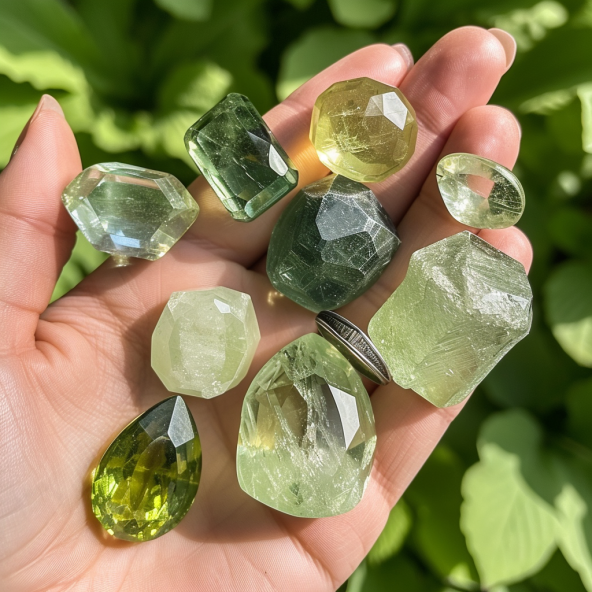
Green Beryl Irradiated
Irradiation and radiation are processes used in the gemstone industry to alter the color or other physical properties of gemstones. These processes involve exposing gemstones to controlled levels of radiation to induce changes in their atomic structure or color centers. While these treatments can result in beautiful and unique gemstone colors, they also require careful consideration and ethical disclosure.
Irradiation
Considering the Treatments and Enhancements, Irradiation is the process of exposing gemstones to ionizing radiation, such as gamma rays or electrons. This radiation interacts with the gemstone’s atomic structure, causing changes that affect its color. Irradiation is commonly used to create various colors in gemstones and is considered a permanent treatment. Some key points to note about irradiation include:
- Color Enhancement: Irradiation can introduce new color centers or alter existing ones in a gemstone, resulting in a range of vibrant and attractive colors.
- Stability: When done properly, irradiation-induced color changes are stable and should not fade over time. However, it’s important to note that extreme heat or prolonged exposure to strong light can potentially affect the color stability.
- Disclosure: Ethical disclosure is essential when selling irradiated gemstones. Buyers have the right to know if a gemstone has undergone irradiation, as this treatment can significantly impact the gem’s value and desirability.
- Lab Reports: Reputable gem laboratories can identify whether a gemstone has been irradiated through testing. Lab reports often include information about the treatment, ensuring transparency for buyers.
Radiation
Radiation is closely related to irradiation but involves using radioactive materials to treat gemstones. The radioactive materials emit radiation that interacts with the gemstone, leading to color changes. This treatment method is less common due to safety concerns and regulatory restrictions. Some key points about radiation treatment include:
- Safety Concerns: Radiation treatments involve working with radioactive materials, which can pose health risks to both the workers and the environment. Proper safety protocols and regulatory compliance are essential.
- Regulations: Radiation treatments are subject to strict regulations in many countries to ensure the safety of workers, consumers, and the environment. Compliance with these regulations is crucial.
- Ethical and Legal Considerations: Due to the potential health and environmental risks associated with radioactive materials, radiation treatments are often met with ethical and legal concerns. In some regions, the use of radioactive materials for gemstone treatment may be prohibited or highly restricted.
Both irradiation and radiation are methods of treating gemstones to alter their color or other properties. While these treatments can lead to stunning results, they must be carried out with ethical consideration and in compliance with safety and regulatory standards. Buyers should always be informed about any treatments a gemstone has undergone, allowing them to make informed decisions about their purchases.
Fracture Filling as Treatments and Enhancements
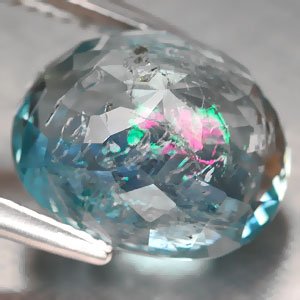
Fracture filling is a common treatment and enhancement technique used in the gem industry to minimize the appearance of cracks and improve the overall clarity of the stone. Also it is a gemstone treatment that involves filling surface-reaching or internal fractures, cavities, or fissures within a gemstone with a substance that improves the gem’s clarity and appearance. This treatment is typically applied to gemstones with visible or significant internal flaws that detract from their beauty and market value. Fracture filling is intended to make these flaws less noticeable and to enhance the gemstone’s overall visual appeal. Here are some key points to understand about fracture filling:
Process of Fracture Filling in Treatments and Enhancements:
- Cleaning: The gemstone is cleaned thoroughly to remove any dirt, dust, or debris from the fractures and cavities.
- Filling: A transparent material, often a glass-like substance or resin, is injected into the fractures or cavities. This material has a refractive index similar to that of the gemstone, which helps to minimize the visibility of the flaws.
- Hardening: The filling material is then cured or hardened using heat, ultraviolet light, or other methods. This solidifies the material and stabilizes the gemstone’s appearance.
Key Points to Note:
- Enhanced Clarity: Fracture filling can significantly improve a gemstone’s clarity by minimizing the appearance of internal fractures and other imperfections. This can make the gemstone more visually appealing and marketable.
- Disclosure: Ethical and transparent disclosure is crucial when dealing with fracture-filled gemstones. Buyers have the right to know that a gemstone has undergone this treatment, as it can impact the gem’s value and durability.
- Durability: While fracture filling can improve the appearance of a gemstone, it may also affect its long-term durability. The filling material might be susceptible to damage from heat, chemicals, and rapid temperature changes. Therefore, care must be taken to avoid exposing fracture-filled gemstones to harsh conditions.
- Maintenance: Over time, the filling material might degrade or wear down, leading to a potential change in the gemstone’s appearance. Regular maintenance and re-filling might be required to maintain the gemstone’s desired appearance.
- Gem Identification: Gemological laboratories can often detect fracture filling through specialized testing and examination. Gem reports from reputable labs will indicate whether a gemstone has been fracture-filled, helping buyers make informed decisions.
- Variety of Gemstones: Fracture filling is commonly used on gemstones such as emeralds, diamonds, and rubies, which often have internal fractures or cavities that can be visually distracting.
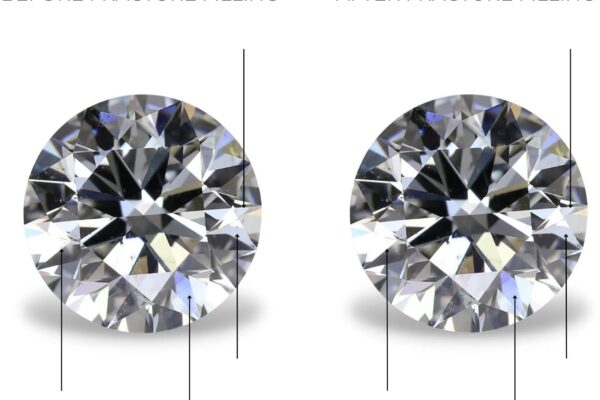
Fracture filling is a treatment used to enhance the clarity and appearance of gemstones by filling internal fractures and cavities with a transparent material. While it can improve a gem’s visual appeal, it’s important for buyers and sellers to be aware of this treatment and to ensure proper disclosure and maintenance to preserve the gemstone’s value over time.
Dyeing and Coating as Treatments and Enhancements
Dyeing and coating are two common techniques employed in the treatment and enhancement of gemstones to alter their appearance, improve color, and increase overall market appeal. These processes are applied to a wide variety of gemstones, including both natural and synthetic stones, with the aim of achieving more vibrant and desirable visual characteristics. While these treatments can enhance a gemstone’s beauty, it’s crucial to understand the methods and their implications before making a purchase, as they can impact the gemstone’s value, durability, and long-term appearance. Further, they are treatments and enhancements in the gem industry, employed to intensify color and enhance luster, respectively.
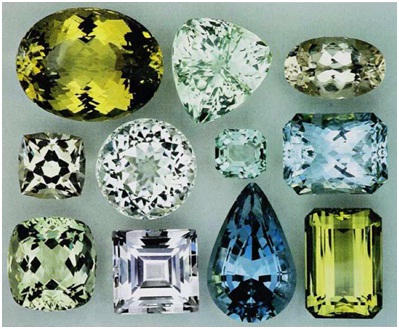
Dyed Multicolor Chalcedony Agate Quartz Pebbles
Dyeing:
Dyeing involves introducing color-enhancing agents, often chemical dyes, into a gemstone’s surface-reaching fissures, fractures, or other porous areas. This process can improve a gemstone’s color by masking undesirable hues or intensifying existing ones. Dyeing is frequently applied to lighter-colored gemstones, such as quartz, agate, and some varieties of jade, to create more visually appealing and marketable colors. The dyes are chosen to be compatible with the gem’s chemical composition and are usually stable under normal wear conditions. However, over time, exposure to sunlight, heat, and harsh chemicals can cause the dyes to fade or change, affecting the gem’s appearance.
Coating:
Coating, on the other hand, involves applying a thin layer of colorless, colored, or iridescent substances onto a gemstone’s surface. These coatings can enhance the gem’s appearance by creating a lustrous or multi-hued effect. Thin film coatings, like metallic oxides or synthetic materials, are often used to create iridescence, similar to the play of colors seen in opals. Coatings can also serve to mask inclusions or fractures, making the gemstone appear clearer and more attractive. However, coatings are typically less durable than the underlying gemstone and can be prone to scratching, peeling, or deteriorating over time and with exposure to wear and tear.
Ethical Considerations
It’s important for buyers and sellers to be transparent about any treatments and enhancements applied to gemstones. Consumers should be informed about the presence of dyes and coatings, as these treatments can significantly affect the value of the gem. Additionally, some treatments might not be considered ethical or legal, such as the undisclosed use of dyes to enhance the color of valuable gemstones like sapphires and rubies.
Dyeing and coating are treatment and enhancement methods used to enhance the appearance of gemstones. These techniques can create stunning and visually appealing effects, but potential buyers should be aware of the implications and potential drawbacks of these treatments. Transparency and understanding the long-term effects are key when considering gemstones that have undergone dyeing or coating processes.
Oil Treatment
Oil treatment, one of the common treatments and enhancements, is used to improve the clarity and overall appearance of certain gemstones, particularly those with visible internal fractures or inclusions. This treatment involves filling the fractures or cavities with a transparent oil or resin to make them less noticeable and to enhance the gem’s visual appeal.

Oiled Spaniel and Tanzanite
Here are some important points to understand about oil treatment:
Process of Oil Treatment:
- Cleaning: The gemstone is thoroughly cleaned to remove any dirt, dust, or debris from the fractures or inclusions.
- Filling: A colorless or transparent oil or resin is carefully introduced into the fractures or cavities. The refractive index of the filling material is chosen to minimize the visibility of the inclusions.
- Stabilization: The filling material is intended to stabilize the gemstone’s appearance and improve its clarity. It can make the inclusions less apparent by reducing their contrast against the surrounding material.
Key Points to Note:
- Enhanced Clarity: Oil treatment can significantly improve a gemstone’s clarity by making internal fractures or inclusions less visible. This can result in a more appealing gemstone.
- Disclosure: Ethical and transparent disclosure is crucial when selling oil-treated gemstones. Buyers should be informed that a gemstone has undergone this treatment, as it can affect the gem’s value and care requirements.
- Durability: While oil treatment can enhance a gemstone’s appearance, the filling material can be susceptible to deterioration over time due to exposure to heat, light, and other environmental factors. Proper care is necessary to maintain the gem’s appearance.
- Maintenance: Over time, the filling material might dry out or migrate within the gemstone, potentially affecting its appearance. Reapplication of the filling material may be required to maintain the gemstone’s desired appearance.
- Gem Identification: Gemological laboratories can often detect oil treatment through specialized testing and examination. Gem reports from reputable labs will indicate whether a gemstone has been oil-treated
- Commonly Treated Gemstones: Emeralds are perhaps the most well-known gemstones that are often oil-treated to improve their clarity. Other gemstones with visible fractures or inclusions, such as certain types of rubies and sapphires, may also undergo this treatment.
Oil treatment is a process used to enhance the clarity and appearance of gemstones by filling internal fractures or inclusions with transparent oils or resins. While it can improve a gemstone’s visual appeal, proper disclosure and care are essential to ensure the gemstone’s value and maintain its appearance over time. In the gem industry, oil treatment is a prevalent enhancement method, especially for emeralds, to reduce the visibility of inclusions and improve the stone’s overall clarity.
Bleaching as Treatments and Enhancements
Bleaching is a chemical treatment and enhancement method commonly used to improve the appearance of certain types of gemstones. The process involves the application of chemicals, usually strong oxidizing or reducing agents, to lighten or remove unwanted colors, thereby enhancing the overall aesthetic quality of the gem. Often employed on gems like pearls, jade, and coral, bleaching is a technique that has been used for centuries to make these precious stones more appealing to consumers.
Method:
The specific bleaching process varies depending on the type of gemstone being treated. Generally, the gem is soaked in a chemical solution for an extended period—sometimes days or weeks—under controlled conditions. For example, pearls might be bleached using hydrogen peroxide, while jade may be bleached using a more potent chemical solution. The chemicals react with the elements causing the undesired color, breaking down the pigments and resulting in a lighter hue.
Benefits:
- Uniformity: Bleaching can produce a more uniform color across the gemstone, thereby increasing its visual appeal and potentially its market value.
- Enhanced Brightness: Lighter-colored gems often appear brighter and more vibrant, making them more desirable to consumers.
- Affordability: Because bleaching can improve the look of otherwise less-desirable gemstones, these treated gems can offer a more affordable option for consumers.
Drawbacks:
- Durability: Bleaching can sometimes weaken the internal structure of the gemstone, making it more susceptible to fractures or other types of damage.
- Permanence: The effects of bleaching are often irreversible, and in some cases, the color may fade or change over time with exposure to light or other environmental factors.
- Ethical Considerations: Disclosure is required when a gemstone has been treated by bleaching, as it affects the value and long-term durability of the stone.
Bleaching, a method among various treatments and enhancements, is widely used in the gemstone industry to enhance the color and overall appearance of specific types of stones. However, like all forms of treatment, it comes with its own set of advantages and disadvantages. As such, it’s crucial for consumers to be informed about the bleaching process and its potential impact on the gemstone’s value and longevity.
Laser Drilling as Treatments and Enhancements
In the intricate world of gemology, the pursuit of maximizing the aesthetic appeal and value of gemstones often involves various treatments and enhancements. One of the most cutting-edge methods in this realm is Laser Drilling, a technique primarily employed to enhance the appearance of diamonds and other precious gemstones.
The Process
Laser Drilling is performed by directing a focused laser beam onto a targeted inclusion or imperfection within a gemstone related to the treatments and enhancement. The laser generates a high degree of heat that vaporizes the inclusion or creates a microscopic channel to reach it. If the inclusion is not completely vaporized, post-drilling treatments often involve dissolving it by injecting a bleaching agent through the drilled channel. The end result is a gemstone with improved clarity and increased market value.
Advantages:
- Precision: The laser beam can be focused to a microscopic point, allowing for very precise targeting of inclusions without affecting the surrounding material.
- Non-Invasive: Traditional methods can often compromise the structural integrity of a gemstone; laser drilling is far less invasive and thus maintains more of the stone’s original characteristics.
- Enhanced Aesthetic Appeal: By removing or lessening the visibility of inclusions, the overall appearance and clarity of the gemstone are significantly improved.
- Increased Market Value: An enhanced gemstone, particularly diamonds, can sometimes be sold at a higher price point due to improved clarity grades.
Considerations
- Disclosure: It’s crucial for buyers to be informed if a gemstone has undergone laser drilling, as this affects its value and may require special care.
- Longevity: While laser drilling is generally considered permanent, the bleaching agents used to dissolve inclusions may deteriorate over time, which could affect the stone’s appearance.
- Limited Applicability: Not all types of inclusions or gemstones are suitable candidates for laser drilling.
Laser Drilling offers a potent means of enhancing the beauty and value of gemstones, leveraging modern technology to advance age-old desires for aesthetic perfection. Like any other treatment, however, it comes with its own set of considerations and ethical implications that both sellers and consumers should be fully aware of.
Surface Coatings as Treatments and Enhancements
The quest for treatments and enhancements to augment the natural beauty of gemstones is as old as the gemstone trade itself. Surface coatings represent one of the many methods utilized to improve the appearance and appeal of gems. This technique has evolved over time from rudimentary waxes and oils to more advanced substances, making it an integral part of modern gemology.
What are Surface Coatings?
Surface coatings involve the application of a thin layer of material—such as lacquer, polymer, or specialized films—onto the surface of a gemstone. The purpose is to enhance color, improve luster, or mask imperfections and inclusions. For instance, coatings can be applied to make a gem appear a more vivid color or to add a layer of sparkle that might otherwise be missing.
Advantages
- Aesthetic Enhancement: Surface coatings can significantly amplify the natural beauty of a gemstone, making colors pop or adding a shimmering luster.
- Affordability: Surface treatments are often less expensive than other forms of enhancement, making them accessible to a broader audience.
- Versatility: The wide variety of coatings available makes it a versatile option for enhancing a range of gemstones.
- Temporary Change: For those looking for non-permanent treatments, coatings can often be removed without causing damage to the original stone.
Considerations
- Durability: Many surface coatings are not permanent and may wear off over time, requiring reapplication.
- Disclosure: It is essential for both buyers and sellers to disclose if a gemstone has been coated, as it affects the stone’s market value and care requirements.
- Care Requirements: Coated gemstones may require special handling to prevent the coating from scratching or wearing off.
- Ethical Concerns: Full disclosure about the presence and type of coating is vital, particularly because some coatings may create an illusion of a higher-quality gemstone.
- Limited Applicability: Not all gemstones are suitable candidates for surface coatings, as the chemical composition of the stone and the coating must be compatible.
Diffusion Treatment as Treatments and Enhancements
In the gemstone industry, diffusion treatment, one of the many treatments and enhancements, is used to improve the color and/or clarity of a gemstone. This is often done to improve the gemstone’s appearance and increase its market value. The most commonly diffused gemstones include sapphires and rubies, although other gemstones can be subject to this process as well.
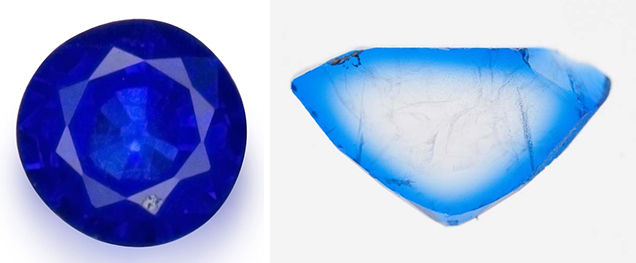
Cobalt Diffusion Treatment Of Natural Spinel
How Diffusion Treatment Works:
- High Temperature: The gemstone is exposed to high temperatures, often in excess of 1600°C (2900°F), to make its crystal structure more receptive to diffusion.
- Chemical Agents: The stone is exposed to a chemical environment in which elements like beryllium, titanium, or chromium are diffused into the outer layer of the gemstone. These elements bond with the existing crystal structure.
- Color Enhancement: The elements that are diffused into the gemstone can affect its color. For example, blue sapphires can be made to appear more vibrant through titanium diffusion.
- Duration: The length of time the gemstone is exposed to this process can vary from a few hours to several days, depending on the desired results.
Pros and Cons:
Pros:
- Improved Appearance: One of the most significant advantages is the improvement in the color and clarity of the gemstone, making it more attractive and marketable.
- Affordability: Diffusion-treated gemstones are generally less expensive than their untreated counterparts of similar appearance.
Cons:
- Durability: The diffusion process typically affects only the surface layer of the gemstone, meaning that if the stone is scratched or re-cut, the original, less desirable color may become visible.
- Value: While diffusion treatment makes the stone look more attractive, it often reduces the gem’s value to collectors and purists, who generally prefer untreated stones.
- Disclosure: Unfortunately, not all dealers disclose that a gemstone has been diffusion-treated, which can mislead consumers.
- Identification: For the average consumer, identifying a diffusion-treated gemstone can be challenging without specialized equipment or expertise.
Ethical Concerns:
Lack of disclosure about the treatment and enhancement of gemstones can raise ethical issues. Full disclosure of any treatments is considered a best practice in the gemstone industry.
If you are considering buying a gemstone, it’s important to ask the seller whether the stone has been treated in any way, including through diffusion, and how that affects its care requirements and value. Always seek certification from reputable labs that can confirm the nature and extent of any treatments.